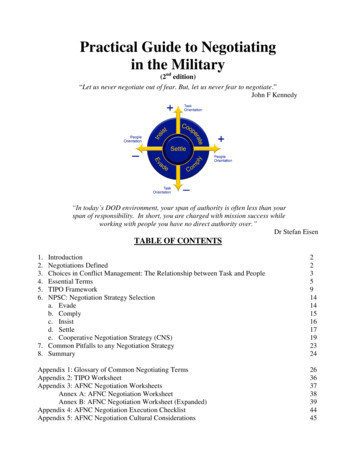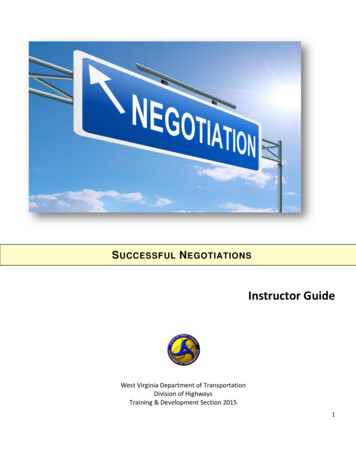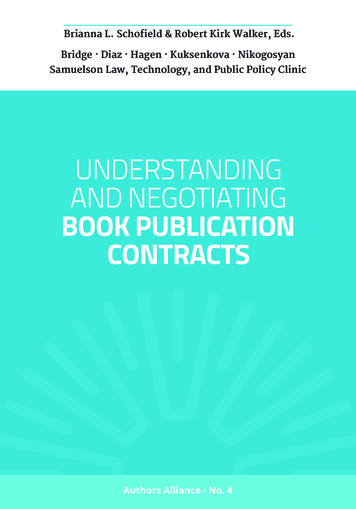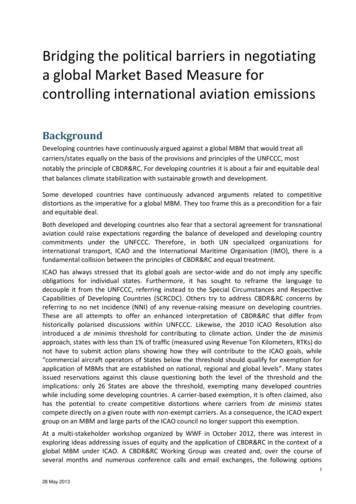
Transcription
Practical Guide to Negotiatingin the Military(2nd edition)“Let us never negotiate out of fear. But, let us never fear to negotiate.”John F Kennedy“In today’s DOD environment, your span of authority is often less than yourspan of responsibility. In short, you are charged with mission success whileworking with people you have no direct authority over.”Dr Stefan EisenTABLE OF CONTENTS1.2.3.4.5.6.IntroductionNegotiations DefinedChoices in Conflict Management: The Relationship between Task and PeopleEssential TermsTIPO FrameworkNPSC: Negotiation Strategy Selectiona. Evadeb. Complyc. Insistd. Settlee. Cooperative Negotiation Strategy (CNS)7. Common Pitfalls to any Negotiation Strategy8. Summary223591414151617192324Appendix 1: Glossary of Common Negotiating TermsAppendix 2: TIPO WorksheetAppendix 3: AFNC Negotiation WorksheetsAnnex A: AFNC Negotiation WorksheetAnnex B: AFNC Negotiation Worksheet (Expanded)Appendix 4: AFNC Negotiation Execution ChecklistAppendix 5: AFNC Negotiation Cultural Considerations26363738394445
INTRODUCTIONMilitary leaders do not operate in isolation. Because of our professional duties and oursocial natures, we constantly interact with others in many contexts. Often the interaction’s purposeis to solve a problem; getting two or more people (or groups of people) to decide on a course ofaction to accomplish a goal. Virtually every problem solving process we attempt involves someaspect of negotiations. Practically speaking, Air Force personnel engage daily in negotiations withco-workers, supervisors, subordinates, business partners, coalition warfighters, non-governmentalorganizations, etc. On-duty, you could be negotiating a scheduling issue between Operations andMaintenance or perhaps a Memorandum of Agreement between two agencies. Later, off duty, itcould be deciding on a Saturday who will 1) take the kids to soccer while 2) the other parent buysthe groceries so 3) the entire family can meet for a sit-down dinner.In the Air Force, senior leaders have identified negotiation skills as a critical core leadershipcompetency. Air Force Doctrine Document 1-1 Leadership and Force Development (8 Nov 2011)under “People/Team Competencies” and the Air Force Policy Directive 36-26 (27 Aug 2008), under“Fostering Collaborative Relationships” highlight the competencies of “Influencing” and / or“Negotiating.” Additionally, in today’s complex environment, the need to work within more peerbased relationships, and the need to communicate across service, joint, interagency, and coalitionenvironments, all point to the value of understanding and effectively applying negotiating skills.Leadership articles and books, whether addressing senior leader skills or broader leadershipcompetencies that all Airmen should develop, are consistent in advocating for improvednegotiations skills as a core leadership competency.This guide builds on the original 2009 NCE primer, Warrior / Negotiator: No Longer anOxymoron, but a Necessity.1 This guide outlines and provides frameworks for assessing and usingfive essential negotiating strategies tailored to the military environment. Each has its strengths andweaknesses. By understanding these five strategies, you can evaluate the situation and select themost appropriate strategy.1. NEGOTIATIONS DEFINEDFirst, we need to define negotiations to frame the discussion. A negotiation is not whatmany envision – a “smoke-filled back room” where bare-knuckled deals are hammered out betweenrival parties. Rather the process of negotiation is much more broadly defined. A negotiation isreally a communication process between two or more parties. This process may range from an openand cordial discussion with a free exchange of information as parties cooperatively seek to satisfycommon interests to something closed and adversarial, where information is hoarded as parties fightto satisfy only their own positions, and if needed, destroy the opposite’s ability to achieve theirs(Note: in this primer, the other party in a negotiation is always referred to as the “opposite”). Inthe middle is a bargaining option where you “give some and gain some.”A negotiation tries to resolve conflict. The conflict may be categorized as a conflict over“structure” (the process or how things get done), “data” (the interpretation of available facts, etc.),“relationships” (working through the real or perceived reputation of the other), “worldview” (howpeople see, assess and judge events around them, i.e. culture), and / or “priorities” (the importancepeople place on things or ideas). This conflict is not always bad. From the ashes of conflict can2
arise win-win solutions meeting interests of both parties. In many situations, conflict can actuallymotivate people to innovate and solve their problems. In popular terms: “Necessity is the motherof invention.” 2Based on the above, let’s refine the definition. The AFNC defines negotiation as a processwhere a conflict at some level exits between at least two parties and at least one of them ismotivated to resolve the conflict. The words in the definition’s second part “ at least one of themis motivated ” are chosen deliberately. It illustrates the point that often, at the beginning of anegotiation, not all parties are motivated to engage in the resolution process due to many factors,such as low trust, information, power and / or options (TIPO, an acronym discussed later in thisguide).2. CHOICES IN CONFLICT MANAGEMENT: The Relationship betweenTask and PeopleFigure 1. The Negotiation Preferences and Styles Chart (NPSC)3There are two variables that form the structure for determining your choice of the fivenegotiation strategies (see Figure 1 above). Every negotiation involves some sort of task (problem)and requires the interaction of two or more people or groups of people (relationship). With theNPSC’s two axes, People versus Task, you can visualize each variable’s relative importance. Thetwo variables’ (task and people) relative importance to each other forms the framework used tovisualize and understand the differences between the strategies. From that, you may select astrategy reflecting those two variables. A description of these variables is provided below.The first variable is people orientation, also called the relationship variable, and isplotted along the horizontal axis on the styles chart. In other words, how important is it for youto develop and/or maintain a productive, trusting relationship with the opposite. This should not beconfused with a friendship. Although it may be beneficial, it is not necessary to like someone towork with them. However a positive relationship value means that you intend to consider theopposite’s needs and desires concerning the topic of the negotiation as well as intending to providethe opposite truthful information and expecting to receive truthful information in return. On theother end of this spectrum, if you disregard or even want to harm the relationship, the people orrelationship orientation variable takes on a negative value. This means you intend neither toconsider the opposite’s needs and desires nor do you trust the information the opposite provides.3
Additionally, although you shouldn’t lie to the opposite when providing information (adherence tostandards of conduct, honor, and ethics should always prevail), you probably won’t provide fulldisclosure, even to the point of being vague or in the extreme, misleading. A fine ethical line existsand due diligence is needed when negotiating in a “dis-trusting” environment.Trust is central to the relationship variable – actively managing a trusting relationship (ordisregarding the relationship) should be a deliberate decision. When deciding which strategy topursue, the frequency of interaction is an important factor. For example, sometimes you maynegotiate a “one-time” deal with little or no chance of ever re-engaging with the opposite. Thismight guide you to disregard the relationship as you pursue your goals. However, if interaction isexpected to re-occur, perhaps in the agreement’s execution, or if multiple negotiations may occurover a period of time, trust-building becomes much more important and may steer the strategyselection. Likewise, if maintaining your positive reputation is important, the relationshiporientation variable may take on a high value even if multiple negotiations are not expected with thecurrent “opposite.” You might not ever deal with that “opposite” again, but you may be dealingwith his / her friend, associate, or in a cross-cultural environment, a family/tribe member. Theclassic example is the local car dealer who prides themselves on honest deals and service for alifetime. They will often accept a lower short-term profit to gain a long-term customer relationship.In DOD, “office reputations” ranging from he/she is “good people” to “what a piece of work –beware the dark side” can often predispose the working relationship, aka the negotiations.Another factor to consider when you assess the relationship’s importance is how much youmay need the opposite’s involvement in the negotiation process. If you need the opposite’s power(referent, expert, reward, coercive, position power, etc.) and/or you need the opposite’s participationto develop potential options, you need to maintain or build a positive relationship. This will guideyour strategy selection. Conversely, if you don’t value the opposite’s power (or you have sufficientpower to act unilaterally) or you don’t value the opposite’s participation in the process (basicallyyou have already determined the single solution and have the ability to impose the solution), yourpeople orientation may be low or negative and as such will guide your negotiation strategyselection.The second variable is task orientation and is plotted along the vertical axis on thestyles chart. In the NPSC, task orientation refers to the importance of resolving the problem tomeet your needs. In the military context, it is getting the mission done. A high task orientationmeans that you are very motivated to resolve the problem in a way that satisfies your interests.Conversely, a negative task orientation means that you don’t seek a resolution to the problem(perhaps you are satisfied with the status quo), you have no preferences with any of the possiblesolutions on the table (anything would work for you), or you may not understand the problem (havepoor task/mission clarity).It is understandably difficult for military leaders to imagine a time when they would not seekimmediate “mission success.” Past operational environments fostered this singular thinking.Today’s and tomorrow’s more complex environments now present a situation where only “gettingtoday’s mission done” could result in a negative value. Your mission directive may allow you theflexibility to decrease your emphasis on the immediate task orientation to gain the actual objectivein the longer term. Not forcefully imposing a solution today that demands absolute compliance mayallow you and the opposite an opportunity to discover a cooperative settlement in the future. This isillustrated later in the discussion of the five negotiating strategies.4
3. ESSENTIAL TERMSEvery skill set comes with its own language, from maintaining ground equipment, managinga satellite or flying an aircraft or UAV. A negotiation has its own language. In the next fewparagraphs, the essential terms are outlined, to enable a more complete understanding of the TIPOand NPSC concepts.4 A robust glossary of useful negotiation terms is attached as Appendix 1.a. Position: a position is “what you want;” what you envision as your best possible outcome.However, to be useful in negotiations, this “best possible outcome” must be rationally bounded.Getting a new car for free may be a fantastic position, but it is not rationally bounded. To be aviable position, it should meet some standard for reasonableness, and also be accepted as reasonableby the opposite. If not, negotiations may stall or be broken off.b. Interest: An interest is one or more underlying reasons for why you are aspiring to yourposition. To help determine interests, investigate your position through a series of interrogativequestions. Interrogative, or critical thinking (CT), questions are the “who, what, when, where, howmuch” and especially “why” questions. Answers to these questions help reveal the underlyingreasons and rationale for a position. If these interrogative questions cannot be successfullyanswered, then the validity of the position may be in question.As an example, your position in a negotiation with HHQ may be for more flying hours.Asking the interrogative questions may reveal the reasons behind the position: flying safety,equipment maintenance, aircrew proficiency, a desire for upgrades, or a myriad of other reasons.For example, perhaps one of the responses to the “why” question was for more training on theupgraded equipment just installed in the aircraft. The position (what you want) may still be moreflying hours, but this interest (the need for more training on the upgraded equipment) is why youwant the hours. Understanding the interests may open up a discussion for alternative ways to getthe training – i.e. other ways to get the job done than just through “more flying hours”.There are three basic types of interests; procedural, psychological and substantive. Effectivenegotiations depend on understanding the types of interests. Procedural interests are thoseconcerning how a process is conducted. Negotiators with procedural interests are highly concernedwith how the outcome is determined, and not as concerned with the actual details of the outcome.For example, if an employee files a formal complaint due to non-selection for training, a savvynegotiator will ask if they think the outcome was unfair or if they think the selection process wasbiased. If the employee feels the selection process was biased, they have a procedural interest.Proving to the employee that the selection process was fair would probably resolve the issue, eventhough the outcome (non-selection for training) didn’t change. The second type of interest ispsychological (sometimes called relationship interests). It concerns how people feel, are perceivedand how they relate with others. A person negotiating for a job might be focusing on a specific jobtitle. This is a psychological interest, because it deals primarily with a relationship need, not aphysical one. Finally, and most important, are substantive interests; having to do with things,schedules, prices, salaries, etc. This is the bulk of most negotiations; however, negotiators shouldalways work to identify and categorize the interests and then work at developing solutions thataddress the type of interest. Offering someone a high salary (substantive interest) might not work ifthe top interest of the prospective hire is a large corner office (psychological interest).5c. Aspiration Point: An aspiration point is the best each party hopes to get out of anegotiated agreement--what each party aspires, or desires, to achieve.6 As with a position, setting a5
rationally bounded aspiration point helps create a positive negotiating environment. However, moreaggressive negotiations tend to be marked by a wide divergence in parties’ aspiration points. Forexample, when negotiating your holiday work schedule in a unit that runs 24/7, you might have anaspiration point of getting to take leave during the entire Christmas holiday (from Christmas Eve toNew Year’s Day), while the unit scheduler’s aspiration point might be two days. To be useful, anaspiration point should be rationally bounded.d. Reservation Point or Bottom Line: In many negotiations, the reservation point is theleast favorable option or offer either side might accept (for example, the lowest price a seller willaccept, or the highest price a buyer will pay). If the agreement doesn’t fall between both parties’reservation points, then the likelihood of entering into the agreement is low and negotiations maycease as one party elects to execute its best alternative to a negotiated agreement (BATNA). 7e. Bargaining Range and Zone of Possible Agreement (ZOPA): The area between eachparty’s aspiration and reservation points defines their own bargaining range.8 Critical to thisdefinition is understanding that any overlap between two parties’ bargaining ranges defines theirZOPA. If there is no overlap, there is no ZOPA.9As an example, let’s say you are negotiating that holiday break. Your aspiration point isgetting the entire holiday period as leave, a total of 8 days. Your reservation point may be thatyou’ll agree to only three days, Christmas Eve through the 26th of December (the 26th being yourspouse’s birthday). The scheduling office’s aspiration point may be to give you no more than twodays off total during this holiday period from Christmas to New Year’s, but as a reservation point,would accept as much as five days off total, as long as it didn’t include both the 24-25 December(Christmas Eve / Christmas Day) and 31 December – 1 January (New Year’s Eve / New Year’sDay). The ZOPA would then range from three days (to include December 26th) to five days (butcan’t include both of the holidays as described above).f. Anchoring: Anchoring is a common negotiating tactic. When a person makes an offer,they are providing the other party some indication of their aspiration point and bargaining zone.Anchoring is a tactic that creates an offer that is at the limit of (or slightly beyond) the rationalitytest assigned to the aspiration point. The expectation is that the anchor will reduce the other side’sexpectations. Research strongly suggests that in simple bargaining situations, known as the Settlestrategy in this article, the stronger one’s anchor, the closer the final agreement is to thatnegotiator’s aspiration point.10 Negotiators who make modest offers do not usually do as well asthose who open with more optimistic anchors. This is common in the retail business, especially forbig ticket items. Retailers will set an “anchor price” in bold print (such as the MSRP or the“Package Value” of bundled items) and then offer you a significant discount – and usually do muchbetter than if they would advertise their actual cost for that product and add their mark-up.11g. Demand: A demand is a statement of terms with no room for adjustment. It is verypositional and embodies the most precise use of a “take it or leave it” option. A demand is presentedat face value, allowing no opportunity for adjustments or adaptation to new information, ideas, oroptions. When making a demand, the negotiator is stating a reservation point and an aspiration pointsimultaneously. A demand is a feature of the Insist Strategy.h. Offer: Like a demand, an offer is a statement of terms, but it anticipates counter-offers,counter-proposals, and modification. It is much more flexible than a demand since the negotiatoranticipates that once the offer is made, it’ll be adjusted to some degree. Sometimes offers are made6
that exceed the aspiration point, as in anchoring, with the anticipation that the counter-offer willprobably shrink expectations.12i. Divergent / Convergent Thinking: All people can operate in either thinking process, butoperating outside one’s preference requires deliberate effort. As examples, most engineers preferconvergent thinking, and most artists prefer divergent thinking. Divergent thinkers tend to seeproblems as opportunities. Convergent thinkers tend to see problems as obstacles. For divergentthinkers, the problem is a starting point from which to imagine solutions. For convergent thinkers,the problem is a target to be destroyed, managed, or overcome.Divergent thinkers’ mental processes tend to be creative and spontaneous. They arecomfortable with uncertainty and ambiguity. They prefer flexible plans with as many options aspossible. “Divergers” tend to dislike settling on one solution and continually search for alternatives.Divergers work at continuously adding options to the table.Divergent Thinking strengths include:1. Capable problem solvers when working novel issues.2. Creative, not limited by conventional boundaries, such as budget, policy, and/orprecedent.3. Comfortable with uncertainty and ambiguity.Divergent Thinking weaknesses include:1. Dislike of finality may result in pushing or missing deadlines.2. Most thinking is outside the box; in fact, often don’t even know where the box is.3. Resist boundaries and limitations; see them as negatively impacting the creativeproblem solving process.Convergent thinkers’ mental processes tend to be reliable and rational, and principle-based.They constantly work to reduce uncertainty and ambiguity. They prefer thorough plans that fullyaddress all contingencies; however, convergers are most comfortable when one clear solution hasbeen identified. Once a solution is identified, convergers prefer to discontinue consideringalternatives and focus on finding support for the preferred solution. Convergers work atcontinuously taking options off the table.Convergent Thinking strengths include:1. Capable problem solvers in crisis or emergency situations.2. Effective problem solvers within conventional boundaries, such as budget, policy,and/or precedent.3. See limitations as guideposts rather than impediments to the problem solvingprocess.Convergent Thinking weaknesses include:1. Once convergent thinkers have decided on a solution, and are marshalling supportfor that solution, they often ignore or dismiss new or contrary information.2. Starting point for problem solving is “inside the box.”j. The Best Alternative to a Negotiated Agreement (BATNA): BATNAs 13 are elegantlysimple in concept, but notoriously difficult to execute. A BATNA is the option a negotiating partymight execute should the negotiations fail. The key is you must be able to execute a BATNAwithout the involvement of the opposite. A BATNA is not the negotiation’s “bottom line” – aBATNA is something you may wish to do if an acceptable “bottom line” cannot be achieved during7
the negotiations. You should always know and update or improve your BATNA and alwaysestimate (and attempt to influence) the opposite’s BATNA.There are three keys to determining a valid BATNA:1. It must be an option that you can execute unilaterally (without any action orinteraction with the other negotiating party). A BATNA is not a BATNA if itrequires the participation of the opposite.2. It must be a real option. It must be something you can and are willing to do (youhave the time, resources, and will to execute).3. Finally, it must be perceived as credible by the opposite. You may believe youwill execute your BATNA, but unless the opposite also believes your BATNA’scredibility, it is useless. As an example, if you are negotiating with other basepersonnel on an office move, and it is getting nowhere, a strong BATNA would bethat your current office space is adequate to do the mission, and it is available for theforeseeable future. A weak BATNA would be that your current office area iscramped, the electrical system unsafe, and it is due to be demolished in three weeks.A useless BATNA is telling the other side your current office space is adequate to dothe mission, and they know the contract to demolish your building was just awardedand begins in 14 days.BATNAs may change during the negotiation as information and conditions change. Forexample, you may be looking for a new car and currently have a good BATNA (your current car isin excellent condition). However, your BATNA would change considerably if your car gotsideswiped in tomorrow’s commute.BATNA is brought up here before the detailed discussion of the five negotiating strategiesbecause it is a useful tool in four of the five strategies (Insist, Evade, Settle, Cooperate but notComply). Of note, in the Cooperative Negotiating Strategy (CNS) there is an extra effort to identifyand manage both sides’ BATNAs. Additionally, since CNS has relatively more engagement (inboth depth and duration) than the other strategies, there is an opportunity within CNS to bettermanage BATNAs. In short, BATNA has applicability in many negotiating strategies, but can beexercised to its fullest potential using the CNS.k. Distributive and Integrative Negotiations: There are two basic categories that virtuallyall negotiation strategies fall into: distributive and integrative.14 The distributive category assumesresources are limited. The task of any distributive negotiating process is to divide up a fixed set ofresources. The distributive category is also known as “value claiming,” because the objective is toclaim a portion of whatever value is on the table. In distributive or value-claiming negotiations,negotiators usually meet to exchange proposals, offers, and counter-offers.Distributive negotiations are essentially zero-sum.15 Because resources are seen as fixed andlimited, any gain by one side represents a loss for the other. Conflict is seen as inevitable, andcompetition rather than cooperation guides negotiations. Parties to the negotiation often perceive theother side as an enemy, a barrier to their success. In a competitive situation, information is regardedas a source of power, and therefore protected. Because information is seen as a source ofnegotiating power, deception may occur, so distrust is characteristic of this approach. This is one ofthe most serious drawbacks of distributive bargaining for military negotiators. The zero-sumapproach can be executed through one of three negotiating strategies presented in this article;parties can “comply,” “insist,” or “settle.”8
Second, the integrative category, while still acknowledging that in the end, resources mustbe distributed (there is “value claiming” at some point in any negotiation), does not see resources asnecessarily fixed. This means that integrative negotiations are not necessarily zero sum. Conflict isnot seen as inevitable; there is the possibility for mutually beneficial, “value creating” cooperationbetween the parties. Negotiators see the other side as potential partners in the problem solvingprocess. Cooperation between the parties has the potential to “create new value” from the existingresources under consideration by combining them in new ways or using the resources in differentways. In this value-creating process, trust-building measures are actively pursued to help develop acooperative environment. Information is shared between the parties, and power is also shared. Thisapproach can be executed through a “cooperative” (or win-win) negotiations strategy. Thecooperative negotiator is concerned with maximizing absolute gains while simultaneously meetingthe counterpart’s interests, rather than maximizing their relative gains over the other party. In thisstrategy, the negotiator’s goal is to arrive at an agreement that satisfies the most important interestsof all parties. As a general rule, except in cases of unambiguous emergency, the authors argue thatmilitary negotiators will achieve better solutions by using the integrative category. One hallmark ofintegrative negotiation is asking questions of all sides about their interests, concerns, andcircumstances; this approach is advocated in AFDD 1-1 Leadership and Force Development, whichrecently added fostering collaborative relationships and negotiating to the USAF institutionalcompetency list.16It is suggested that agreements reached by integrative means will be more sustainable, andwill tend to enhance relationships, whereas distributive negotiation tends to degrade relationships.Lack of cross-cultural competence intensifies this harm. It is suggested that combining crosscultural competence with integrative negotiation skills leads to better relationships, betteragreements, and, therefore, serves tactical and strategic objectives.4. TRUST, INFORMATION, POWER and OPTIONS (TIPO) Analysis17FrameworkBefore describing the five NPSC strategies, a simple framework may help you assess yoursituation which, in turn, will guide your NPSC negotiating strategy selection. Also, the TIPO(pronounced “typo”) framework can help you understand why your opposite selected thenegotiating strategy they may be using with you. The TIPO framework models how trust,information, and power, influence the way you develop options to solve the current problem.INFORMATIONYours / TheirsTRUSTProcess / PersonalOPTION(S)One / ManyPOWERWith / OverFigure 2. Trust, Information, Power, and Options (TIPO) Analysis Framework9
TRUST: To start TIPO, you assess the type of trust between you and the opposite. In thisdiscussion, trust is defined as your belief /evidence that the opposite’s interactions with you are orwill be genuine and truthful. The more belief /evidence you have that the opposite’s interactions aregenuine and truthful, the more trusting you are of all the opposite’s actions and intentions. Trustdoes not equate with confidence. Sometimes you may have high confidence that the opposite istrying to deceive you – that might be a good thing to know if you intend to negotiate with them.Usually, high trust is associated with positive outcomes, such as believing the information theyprovide you is accurate or knowing they will run the meeting according to the agreed agenda andnot blindside you. Knowing how to detect trust is a challenge, but must be mastered.Trust may be categorized into at least two major categories; trust in a process or trust in aperson. Process trust exists when both parties believe in and have faith in an institution that willsupport the negotiations process. For example, process trust can exist in a real estate negotiationwhen both parties trust that banking and real estate laws will support whatever agreement theydevelop. They do not have to know each other to have trust in the process. Process trust also existsin the military culture, such as the Inspector General complaint system, equal oppor
environments, all point to the value of understanding and effectively applying negotiating skills. Leadership articles and books, whether addressing senior leader skills or broader leadership competencies that all Airmen should develop, are consistent in advocating for improved negotiations










